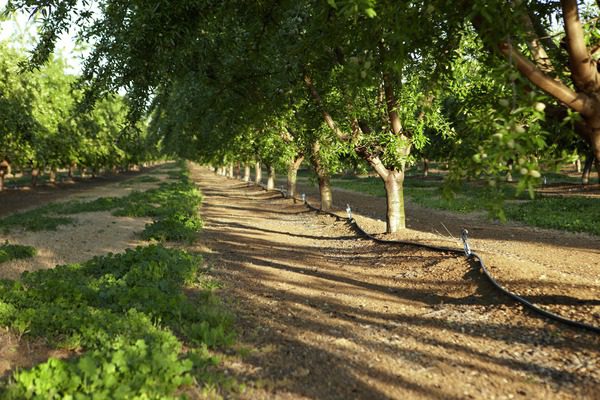God blessed us with a darn good slug of water in most parts of the state and the Sierra Nevadas are certainly holding an abundance more in snowpack. Shasta and Orville are way above historical averages, and typically, Oroville gets filled with snow melt more than rain fall. Add that up and we may see it full again for only the second time in its history! To kick things off correctly, let’s make a plan.
Nutrition
This will be a tough start to the year for many farmers in the walnut and almond industries. With prices at significant deficits, many farmers chose to abstain from adding soil amendments to their fields this fall. Let’s look at two scenarios:
Scenario #1
You applied compost. Hopefully, you worked it in a couple inches to avoid degradation and volatility. With that application, it provided some nutrients and organic matter (carbon) as well as some active biology. Nice work. If didn’t, you can skip the middlemen right now (time, weather, pH, etc.). Many companies sell active brews of biology that you can run through your drip or sprinklers (full disclosure, the company I work for does too, so I am biased by my experience and observations.) Let’s make it more effective; add organic acids, which is what we hope the compost eventually breaks down to, and keep the biology colonizing and propagating. That’s a lot of extra carbon. The roots will love the that immediate source of carbon. You’ll hold more nutrients that become available or are applied as well.
Scenario #2
You applied gypsum. If you do the math, you applied twice the amount of calcium needed in-season with each ton. The problem is its solubility is lethargic at best. Without active biology, low pH water and weathering, it won’t be available for a while. I’ll use my old analogy of meat: If you are hungry, a cooked steak is better than a frozen side of beef. The second is way more than you can use with no way to eat it. Let’s add to that. If the soil is your refrigerator and you fill it with the side of beef, there isn’t much room for any other food. However, if you did add a ton or two of gypsum, add some active biology to your soil to eat it and break it down. Lower your early water pH to 6 to solubilize more calcium. The roots will love it. If you didn’t apply CaSO4, add some soluble calcium to your early irrigations for root flush at bloom. Couple that with organic acids and biology. Do not apply a year’s supply of phosphorus (15 to 30 units) as a polyphosphate all at once to a single fertigation unless you are trying to make plaster of Paris. You will tie up several nutrients that are critical early in the season.
More specifically on nutrition, look at your nutrient demand curves for your crop. fruitsandnuts.UCDavis.edu has a lot of resources to help you determine when those nutrients are in high demand. N and P demand start high early in the season. Know how much can be taken up at one time. Just because you put out all that it should need in a season doesn’t mean it’ll be there in the root zone, plant-ready and soluble for several weeks. Don’t apply 50 units at a time, three times for three months and hope it all gets assimilated. Apply 15 units, 7 times over 10-day intervals, in short fertigation sets and let me know how that works out for you! I’ve seen it become a significant savings in nutrient costs and a better way to get nutrients into a tree. Overapplication in single events doesn’t translate into better availability. It typically becomes a wasted pile of money. Imagine applying 100 to 120 units N in a more effective way, saving $100/ac and having those April and July tissue tests be sufficient. It’s been eye-opening for quite a few of my clients. Apply your early P in a few smaller shots as well and make sure its orthophosphate. Add a little phosphite to that if you really want to put your roots on steroids! I’ve found that combo to be very effective at increasing early P numbers.
Water
The third component is water. With saturated soils and good, deep moisture, unless we still have a large leaching fraction to overcome, start with shorter sets more often. It’ll keep the roots less soggy when water typically can’t move out of the root zone as quickly in spring and give you the chance to pulse some effective early nutrition into those crops as they push through bloom and leaf expansion. I’ve found that by tweaking that irrigation schedule a little bit, early in the season, we can save a significant amount of water, electricity and total nutrient applications. We should then be getting our trees off to a much better start. It also seems to help keep deep moisture from subbing up until quite a bit later in the season.
When prices are down, we have to optimize our yields while typically cutting some costs. It’s obviously much harder to do than can be explained on paper in less than 1000 words. If we plan ahead and watch every input coupled with a more effective delivery method, we should be able to do just that. Let’s take advantage of this gift of water and use it to our advantage in planning to succeed. Higher yields can help lessen the hit of lower prices.











